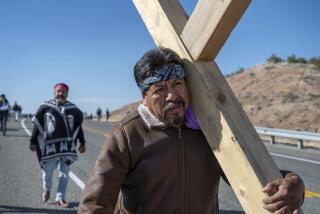Papal Pilgrim in the Holy Land
- Share via
On June 29, 1999, Pope John Paul II published a letter to those preparing to celebrate the Great Jubilee of 2000, explaining why he intended to make a yearlong pilgrimage to the great sites of biblical history. Those sites are typically associated these days with the tangled politics of the Middle East. In his letter, however, John Paul insisted that his “would be an exclusively religious pilgrimage in its nature and purposes,” and added that he “would be saddened if anyone were to attach other meanings to this plan of mine.”
Some will undoubtedly read the pope’s visit to the Holy Land through political and diplomatic filters. That is unavoidable. Yet John Paul also deserves to be taken at his word. His going to Jerusalem, Nazareth and Bethlehem is not a gambit on the chessboard of international politics. He is a pilgrim.
The idea of a “pilgrimage,” a journey to a sacred place for prayer, penance and almsgiving, is ineradicably inscribed in humanity’s religious imagination. In biblical times, faithful Jews went “up to Jerusalem” for the feasts of Passover, Pentecost and Tabernacles. Christian pilgrimage to the Holy Land began early in Christian history. Devout Muslims regard a pilgrimage to Mecca as a solemn religious obligation.
The pilgrimage tradition in biblical religion reflects the grittiness of Jewish and Christian conviction: In certain specific places, at certain definite times, God acted for the salvation of the world. Generations taught by historical-critical scholarship to read the Bible skeptically find this unapologetic geographic specificity a bit startling. Yet anyone who has been on pilgrimage to the holy places knows that there is something different about them.
That difference is not merely the density of historical memories built up over thousands of years. (As an old Holy Land saw has it, “too much history and too little geography.”) Rather, it is a difference that can only be described as “presence”: the presence of a reality that transcends, even as it suffuses, time and space. That “presence,” in the Jewish and Christian view, is quite simply the presence of God. And this God is no metaphysical abstraction, no detached prime mover.
As John Paul wrote in his June 1999 letter, the biblical God is intensely involved in the world He created: “To go in a spirit of prayer from one place to another, from one city to another, helps us not only to live our life as a journey, but also gives us a vivid sense of a God who has gone before us and leads us on, who himself set out on man’s path, a God who does not look down on us from on high, but who became our traveling companion.”
In going to the Holy Land, John Paul II will be carrying the entire Catholic world with him. Peter’s successor will go to Peter’s house in Capernaum, celebrate Mass at the traditional site of the Last Supper, visit the room where Peter received the outpouring of the Holy Spirit. Yet this is also an intensely personal pilgrimage for Karol Wojtyla, who was a Christian disciple long before he was a pope. He first went to the Holy Land in 1963, and his poet’s imagination was seized by the starkness of the Judean wilderness. In a poem-cycle he wrote about the holy places, he described the experience this way: “You seek people out everywhere/But to seek everywhere/You had to stop in some place./This one is chosen by You.” There is the “scandal” of biblical religion, the scandal of universal truths revealed through particular experiences, in two sentences.
Shortly after his election in October 1978, John Paul II told his Vatican collaborators that he’d like to spend his first papal Christmas in Bethlehem. They couldn’t believe it. The Holy See didn’t have diplomatic relations with any state in the region, territories were in dispute, popes didn’t do drop-ins, logistics would be impossible, etc. For one of the few times in his pontificate, John Paul let his evangelical instincts be trumped by his diplomats’ cautiousness. Ever since, however, he has been yearning to walk where Jesus walked, to pray where Jesus prayed and to be present in the places to which the Church owes its origins. Now he returns.
And in going to the Holy Land as a pilgrim, John Paul II is asking the world to think about a mystery that is almost frighteningly tangible: “ . . . to seek everywhere/You had to stop in some place./This one is chosen by You.”
More to Read
Sign up for The Wild
We’ll help you find the best places to hike, bike and run, as well as the perfect silent spots for meditation and yoga.
You may occasionally receive promotional content from the Los Angeles Times.





